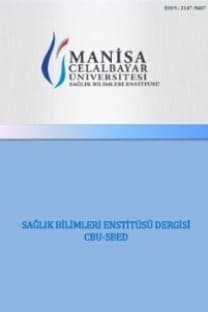Pain Management in Patients with Peripheral Arterial Disease
: Peripheral arterial disease, pain, verbal descriptive pain scale
___
- 1. Hirsch AT, Crigui MH, Treat-Jacobson, Regensteiner JG, Creager MA, Olin JW, Krook SH, Hunnighake DB, Comerota AJ, Walsh ME, McDermott MM, Hiatt WR. Peripheral arterial disease detection, awareness and treatment in primary care. JAMA 2001; 286 (11):1317-24.
- 2. Fried RE. Diagnosis and treatment of peripheral arterial disease. JAMA 2002; 287 (3): 315-6.
- 3. Stoffers HE, Rinkers PE, Kester AD, Kaiser V, Knottnerus JA. The prevalence of asymptomatic and unrecognized peripheral arterial occlusive disease. Int J Epideol 1996; 25 (2): 282-290.
- 4. Karabay Ö, Karaçelik M, Yılık L, Tekin N, Birtan İriz A, Kumdereli S, Gürbüz A, Çalkavur T. İskemik periferik arter hastalığı: Bir tarama çalışması. Türk Göğüs Kalp Damar Cerrahisi Dergisi 2012;20(3): 450-457.
- 5. Bozoğlan O. Diyabetes mellitus ve periferik arter hastalığı. Kahramanmaraş Sütçü İmam Üniversitesi Tıp Fakültesi Dergisi 2015; 10(2): 64-67.
- 6. Yakubov SJ, Bope ET. Cardiovascular disease. In: Rakel RE (ed). Textbook of family practice. 6th edition. Philadelphia: W.B. Saunders; 2002.784.
- 7. Akdemir R, Vatan MB. 2017 Avrupa Kardiyoloji Derneği periferik arter hastalığı tanı ve tedavi klavuzunun getirdiği yenilikler. Türk Kardiyoloji Derneği Arşivi 2017; 45 (8): 681-686.
- 8. Mavioğlu L, Mungan U, Özeke Ö, Çağatay E, Özatik MA. Atipik tutulum gösteren Buerger hastalığı (tromboanjitis obliterans): Olgu sunumu. Türk Göğüs Kalp Damar Cerrahisi Dergisi 2013;21 (4): 1039-1042.
- 9. Cattabriga I, Pacini D, Lamazza G, Talarico F, Di Bartolomeo R, Grillone G, Bacchi-Reggiani L. Intravenous paracetamol as adjunctive treatment for postoperative pain after cardiac surgery: a double blind randomized controlled trial. European Journal of Cardio-thoracic Surgery 2007: 32(3) :527-531.
- 10. Schofield P. Pain management of older people in care homes: a pilot study. Br J Nurs. 2006; 15(9): 509-14.
- 11. Türk Anesteziyoloji ve Reanimasyon Derneği (TARD) Anestezi Uygulama Klavuzları Postoperatif Ağrı Tedavisi Mart 2006.
- 12. Uyar M. Postoperatif ağrılı hastanın değerlendirilmesi, ağrı ölçümü. Yücel A. Postoperatif Analjezi. Mavimer matbacılık, İstanbul 2004,27-36.
- 13. Eti Aslan F. Ağrı değerlendirme yöntemleri. Cumhuriyet Üniversitesi Hemşirelik Yüksekokulu Dergisi 2002 (6): 9-16.
- 14. Woo KY, Abbott LK, Librach L. Evidence-based approach to manage persistent wound-related pain. Current opinion in supportive and palliative care. 2013;7 (1): 86-94.
- 15. Coşkun Ö, Uzun G, Dal D, Yıldız Ş, Sönmez YA, Yurttaş Y, Güler A, Mutluoğlu M, Tekindur Ş, Sarı S, Şahin MA, Zor F, Tanyüksel M. Kronik yarada tedavi yaklaşımları. Gülhane Tıp Dergisi 2016;58: 207-228.
- 16. Takmaz SA. Girişimsel yöntemler ve antikoagülanlar. Ağrı Bülteni 2017; (2): 1-9.
- 17. Caraceni A, Hanks G, Kaasa S, Bennett MI, Brunelli C, Cherny N, Dale O, De Conno, F Fallon M, Hanna M, Haugen DF, Juhl G, King S, Klepstad P, Laugsand EA, Maltoni M, Mercandante S, Nabal M, Pigni A, Radbruch L, Reid C, Sjogren P, Stone PC, Tassinari D, Zeppetella G . Use of opioid analgesics in the treatment of cancer pain: evidence-based recommendations from the EAPC The Lancet Oncology. 2012; 13 (2): 58-68.
- 18. Manchikanti L, Falco FJ, Benyamin RM, Caraway DL, Kaye AD, Helm S,et al. Assesment of bleeding risk of interventional techniques: a best evidence synthesis of practice patterns and perioperative management of anticoagulant and antithrombotic therapy. Pain Physician 2013; 16 (2 Suppl): SE261-318.
- 19. Aubrun F, Kalfon F, Mottet P, Bellanger A,Langeron O, Coriat P, Riou B. Adjunctive analgesia with intravenous propacetamol does not reduce morphine British Journal of Anaesthesia; Mar 2003; 90,3; 314-9.
- 20. Remy C, Marret E, Bonnet F. Effects of acetaminophen on morphine side-effects and consuption after major surgery: meta-analysis of randomized controlled trials. British journal of anaesthesia, Apr 2005; 94 (4): 505-513.
- 21. Yonemitsu Y, Matsumoto T, Itoh H, Okazaki J, Uchiyama M, Yoshida K, et al. DVC1-0101 to treat peripheral arterial disease: A Phase I/IIa Open-label Dose escalation Clinical Trial. Moleculer therapy: The Journal of the American Society of Gene Therapy.2013: 21 (3): 707-714.
- 22. Belch J, Hiatt WR, Baumgartner I, Driver IV, Nikol S, Norgren L, et al. Effect of fibroblast growth factor NV1FGH on amputation and death: a randomised placebo-controlled trial of gene therapy in critical limb ischemia. Lancet. 2011; 377 (9781): 1929-37.
- ISSN: 2147-9607
- Yayın Aralığı: Yılda 4 Sayı
- Başlangıç: 2014
- Yayıncı: Manisa Celal Bayar Üniversitesi Sağlık Bilimleri Enstitüsü
Süperior Pediküllü Retroauriküler Flep ile Kulak Sayvanı Defektlerinin Onarımı
Periferik Arter Hastalığı Olan Hastalarda Ağrı Yönetimi
Nail KAHRAMAN, Buket ÖZYAPRAK, Kurtbey ANARAT, Mehmet GAMLI, Gönül ERKAN, Ahmet EROĞLU
Gebelikte Prenatal Bağlanma ve Vücut Algısı Arasındaki İlişki ve Etkileyen Faktörler
Tuba ÖZKAN, Didem ŞİMŞEK KÜÇÜKKELEPÇE, Semiha AYDIN ÖZKAN
Gebelikte Tromboemboli ve Antikoagülan Kullanımında Ebelik Yaklaşımı
Ünzüle SERİN, Nuran AYDIN ATEŞ, Asiye AYAR KOCATÜRK
Habil YÜCEL, Dilşad AMANVERMEZ ŞENARSLAN
Pain Management in Patients with Peripheral Arterial Disease
Buket ÖZYAPRAK, Kurtbey ANARAT, Mehmet GAMLI, Nail KAHRAMAN, Gönül ERKAN, Ahmet EROĞLU
İntratekal Bupivakain İle Morfinin TUR-M Sonrası Postoperatif Analjeziye Etkisi
Aylin İNCESU, Mustafa Nuri DENİZ, Elvan ERHAN, Gülden UĞUR
Çağdaş Öykü MEMİŞ, BİLGE DOĞAN, Müge BULUT, Yaşan Bilge ŞAİR, Levent SEVİNÇOK
Şizofreni Hastalarının Bakım Verenlerinde İfade Edilen Duygu ve Mizaç Özellikleri Arasındaki İlişki
Bilge DOĞAN, Çağdaş Öykü MEMİŞ, Müge BULUT, Yaşan Bilge ŞAİR, Levent SEVİNÇOK
Şizofreni hastalarının bakım verenlerinde duygu dışa vurum ve mizaç özellikleri ilişkisi
Çağdaş Öykü MEMİŞ, Bilge DOĞAN, Müge BULUT, Yaşan Bilge ŞAİR, Levent SEVİNÇOK
